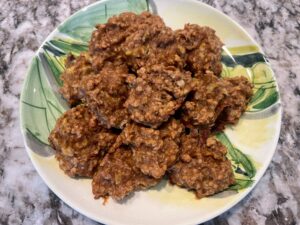If you love making almond milk, you might end up with a lot of leftover almond pulp. I used to throw it away, not knowing what to do with it. Then, I found an easy and natural way to dehydrate almond pulp using sunlight. Now, instead of tossing it, I turn it into something useful and make the most of it.
This guide will show you simple steps to turn your leftover almond pulp into dry, versatile powder for use in various recipes. So, let me help you get started!
Naturally Dehydrate Almond Pulp and More
If you want to reduce waste and find a better way to preserve food, you’re in the right place. Dehydrating leftover almond pulp, along with fruits, vegetables, and nuts, is a smart and cost-effective way to make the most of your ingredients.
After making homemade almond milk, you get almond pulp full of nutrients. Instead of throwing it away, you can dehydrate it for later use. This method works for many foods, helping you get the best from your ingredients.
Using sunlight to dehydrate is an easy, green way to keep the natural flavors and nutrients in your food. Just spread your almond pulp, fruits, or veggies on a clean surface and let the sun do the drying. It saves energy compared to electric dehydrators and adds a bit of sunshine to your food.
Imagine having dried fruit for smoothies, nut powders for baking, or dried veggies for soups. It’s a great way to make your food last longer and keep your kitchen eco-friendly.
Natural Sunlight Magic
Before I found this method of using natural sunlight, I tried several ways to use leftover almond pulp. I first bought an expensive dehydrator, but it didn’t work as well as I hoped. Then, I used my oven, but it was slow, and in the summer, it got too hot and wasn’t very effective.
Then my wise mother told me about a simpler and more natural way she used to dehydrate food before there were fancy tools. I followed her advice, and she was right! it turned out to be much easier and better for dehydrating almond pulp. I also found that the pulp can be used to make almond flour or homemade granola. With just some sunlight and a few simple steps, we discovered its great potential.
The best part is how simple this method is. Also, you don’t need any special equipment or complicated gadgets. If you live in a sunny place like California, you’re in luck. So, let’s dive into the easy process of dehydrating almond pulp using sunlight.
What You Need to Dehydrate
To get started with dehydrating, you’ll need a few key items:
1. Select Your Ingredients: Choose the food you want to naturally dehydrate, such as almond pulp, vegetables, fruit, or other ingredients.
2. Pick the Right Tray: Use a spacious tray, like a reliable baking tray.
3. Get a Mesh Covering: A mesh covering, such as the one I bought on Amazon, works perfectly.
4. Secure the Covering: Make sure to use a heavy object to keep the mesh covering in place.

Simple Steps for Dehydrating Almond Pulp
1. Choose a Sunny Spot
First, spread the wet almond pulp on a large tray in a thin single layer. Then, find the sunniest spot in your outdoor space where it gets direct sunlight all day. Avoid shaded areas and obstructions like trees or buildings.
Place your tray somewhere high up to keep it safe from pets or critters. Also, make sure there’s a good air circulation to speed up the natural drying process and prevent moisture buildup.
2. Cover with Mesh
Place a mesh covering over the tray to protect almond pulps from insects and debris. This step is important for keeping unwanted pests away and ensuring a clean drying setting.
Then, use a heavy object to secure the edges of the mesh. This will prevent the mesh from being blown away by the wind or disturbed by curious pets.
3. Sunbathe the Almond Pulps
Let the almond pulp sit and naturally dehydrate in the sun for about 3 to 4 hours. The exact drying time can vary based on how sunny it is and how much pulp you have. On sunny days, it might take less time than on cloudy days.
Keep an eye on the drying process and adjust the time if needed. This way, you can make sure the almond pulp dries just the way you want it.
4. Check and Reposition
Regularly check and move the almond pulp to ensure it dehydrates evenly. This is important to avoid some parts getting too dry while others stay damp. For example, some areas might get more sunlight than others, so turning or moving the pulp helps it dry more consistently.
By adjusting the position of the pulp from time to time, you make sure it gets natural, even exposure to the sun. This way, all your almond pulp will dry evenly and reach just the right level of dryness.
5. Inspect After 3-4 Hours
After the first drying period, check if the almond pulp is fully dehydrated. If it isn’t, let it sit in the sun for another 3 to 4 hours. This extra time will help remove any remaining moisture and ensure even drying. It will also make the almond pulp consistently dry and ready for storage or use.
6. Avoid Overexposure
Don’t leave the almond pulp out overnight or forget about it, as it can become too dry and lose quality. Instead, keep an eye on it throughout the day. Leaving it out too long can make it too dry, causing it to become brittle or lose flavor.
Make sure to take the almond pulp inside once it’s fully dehydrated to keep it at its best. By carefully managing the drying time, you’ll maintain the quality of your almond pulp.
Turning Almond Pulp into Almond Flour

To make almond flour from dehydrated almond pulp, just blend the pulp in a blender for a few minutes until it’s fine. Then, store the almond flour in a tightly sealed jar.
For longer storage, keep the almond flour in the fridge or freezer. This way, it will stay fresh and be ready for baking, like vegan chocolate chip cookies, or making homemade granola. You’ll always have a handy ingredient for your recipes.














